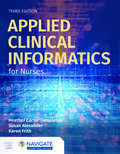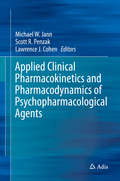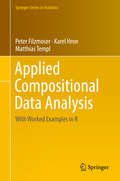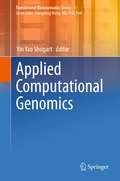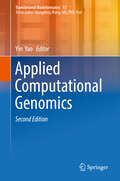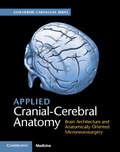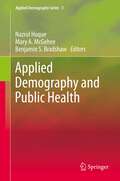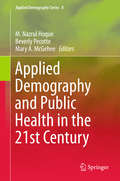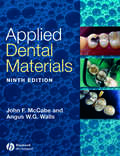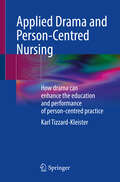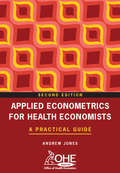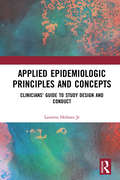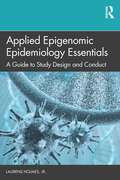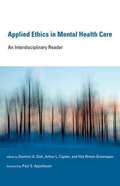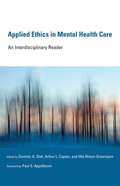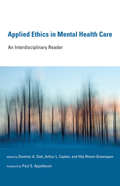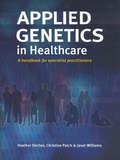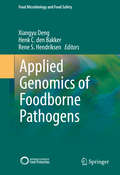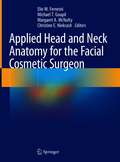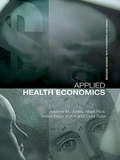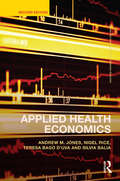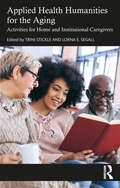- Table View
- List View
Applied Biotechnology and Bioinformatics: Agriculture, Pharmaceutical Research and Environment
by Swagat Kumar Das Hrudayanath Thatoi Sonali Mohapatra Sukanta Kumar PradhanThis comprehensive reference book discusses the convergent and next-generation technologies for product-derived applications relevant to agriculture, pharmaceuticals, nutraceuticals, and the environment. The field of modern biotechnology is a multidisciplinary and groundbreaking area of biology that includes several cutting-edge methods due to developments in forensics and molecular modeling. Bioinformatics is a full-fledged multidisciplinary field that combines advances in computer and information technology. Numerous applications of bioinformatics—primarily in the areas of gene and protein identification, structural and functional prediction, drug development and design, folding of genes and proteins and their complexity, vaccine design, and organism identification—have contributed to the advancement of biotechnology. Biotechnology is also essential to crop improvement in agriculture because it allows genes to transfer across plants to increase traits such as disease resistance and yield. It also plays a broad role in healthcare, including genetic testing, gene therapy, pharmacogenomics, and drug development. Bioremediation and biodegradation, using microbial technologies to clean up environmental contamination, waste management technologies, and the conversion of organic waste to biofuels. Bioinformatics plays a critical role in analyzing different types of data created by high-throughput research methods—such as genomic, transcriptomic, and proteomic datasets—that are useful in addressing various problems related to disease management, clean environment, alternative energy sources, agricultural productivity, and more. Audience The book will interest biotechnology researchers and bioinformatics professionals working in the areas of applied biotechnology, bioengineering, biomedical sciences, microbiology, agriculture and environmental sciences.
Applied Cerebral Angiography: Normal Anatomy and Vascular Pathology
by Gianni Boris BradacThis book offers detailed guidance on the diagnostic use of cerebral angiography based on precise description of the angiographic appearances of normal anatomy and pathological conditions. In this third edition, every chapter has been thoroughly revised and enlarged to reflect new knowledge and experiences, and more attention is paid to the correlations between anatomopathological findings and clinical manifestations. Beyond explaining the diagnostic value of cerebral angiography, a key aim is to equip readers with the precise knowledge of the anatomy of cerebral vessels required for optimal application of endovascular therapy of pathologies involving the arteries and veins of the brain. As in preceding editions, the book is divided into two parts. The first part describes the normal anatomy, with attention to morphological aspects, embryological development, function, and vascular territories. The intraorbital and extracranial vascularization is also fully considered. The knowledge provided will serve as a sound basis for the correct interpretation of pathological processes and their clinical significance, as covered in depth in the second part of the book.
Applied Clinical Informatics for Nurses
by Heather Carter-Templeton Susan Alexander Karen FrithNurses need to be aware of the latest information, technologies, and research available to provide safe, patient-centered, evidence-based care. Applied Clinical Informatics for Nurses continues its' student-centered approach to nursing informatics in a modern new edition full of illustrations, tables, figures, and boxes that enhance the readers’ experience and assists in comprehension. In the updated Third Edition, the authors emphasize the importance of understanding principles and applications of informatics and apply a context-based teaching approach to enhance clinical decision-making, promote ethical conduct, and improve problem-solving skills. The Third Edition features extensive updates on telehealth, mobile health, and clinical decision support. It also includes expanded information related to software used for data mining and additional case studies to help illustrate creative informatics projects developed by nurses.
Applied Clinical Pharmacokinetics and Pharmacodynamics of Psychopharmacological Agents
by Lawrence J. Cohen Michael W. Jann Scott R. PenzakThisbook is a comprehensive resource on psychotropic medications, detailing thelatest methods for defining their characteristics, their use in differentpatient populations, and drug-drug interactions; an important collection ofinformation forclinicians, students, researchers, and members of thepharmaceutical industry alike. Thefirst section provides the foundational principles of these drugs. Mathematicalmodeling of parameters that affect their entryto,and exit from, the centralnervous system (CNS) compartment are presented on an individual basis and thenapplied to target populations with specific disease states. Methods andcharacteristics that inform the transfer of these drugs from the laboratorybench to use in patient care are discussed, including imaging techniques,genetics and physiological barriers, such as the blood-brain barrier. The secondsection describes the characteristics of specific agents,nominally arrangedintodifferent therapeutic categories and with reference crossover use indifferent disease states. The pharmacologic characteristics of different drugformulations are explored in the context of their ability to improve patientadherence. The third section focuses on drug-drug interactions. Psychotropic medicationsfrom different categories are frequently prescribed together,or alongsidemedications used to treat comorbid conditions, and the information provided isdirectly relevant to the clinic, as a result. Theclinical application of pharmacokinetics and pharmacodynamics of CNS agents hasmade significant progress over the past 50 years and new information is reportedby numerous publications in psychiatry, neurology, and pharmacology. Ourunderstanding of the interrelationship between these medications, receptors,drug transporters, as well as techniques for measurement and monitoring theirinteractions,isfrequently updated. However, with information presented on ahost of different platforms, and in different formats, obtaining the fullpicture can be difficult. This title aims to collate this information into asingle source that can be easily interpreted and applied towards patient careby the clinical practitioner, and act as a reference for all others who have aninterest in psychopharmacological agents.
Applied Compositional Data Analysis: With Worked Examples In R (Springer Series in Statistics)
by Peter Filzmoser Matthias Templ Karel HronThis book presents the statistical analysis of compositional data using the log-ratio approach. It includes a wide range of classical and robust statistical methods adapted for compositional data analysis, such as supervised and unsupervised methods like PCA, correlation analysis, classification and regression. In addition, it considers special data structures like high-dimensional compositions and compositional tables. The methodology introduced is also frequently compared to methods which ignore the specific nature of compositional data. It focuses on practical aspects of compositional data analysis rather than on detailed theoretical derivations, thus issues like graphical visualization and preprocessing (treatment of missing values, zeros, outliers and similar artifacts) form an important part of the book. Since it is primarily intended for researchers and students from applied fields like geochemistry, chemometrics, biology and natural sciences, economics, and social sciences, all the proposed methods are accompanied by worked-out examples in R using the package robCompositions.
Applied Computational Genomics (Translational Bioinformatics #1)
by Yin Yao Shugart"Applied Computational Genomics" focuses on an in-depth review of statistical development and application in the area of human genomics including candidate gene mapping, linkage analysis, population-based, genome-wide association, exon sequencing and whole genome sequencing analysis. The authors are extremely experienced in the area of statistical genomics and will give a detailed introduction of the evolution in the field and critical evaluations of the advantages and disadvantages of the statistical models proposed. They will also share their views on a future shift toward translational biology. The book will be of value to human geneticists, medical doctors, health educators, policy makers, and graduate students majoring in biology, biostatistics, and bioinformatics. Dr. Yin Yao Shugart is investigator in the Intramural Research Program at the National Institute of Mental Health, Bethesda, Maryland USA.
Applied Computational Genomics (Translational Bioinformatics Ser. #1)
by Yin YaoThe volume provides a review of statistical development and application in the area of human genomics, including candidate gene mapping, linkage analysis, population-based genome-wide association, exon sequencing, and whole genome sequencing analysis. The authors are extremely experienced in the field of statistical genomics and will give a detailed introduction to the evolution of the field, as well as critical comments on the advantages and disadvantages of the proposed statistical models. The future directions of translational biology will also be described.
Applied Cranial-Cerebral Anatomy: Brain Architecture and Anatomically Oriented Microneurosurgery
by Guilherme Carvalhal RibasThis book is the first to offer a comprehensive guide to understanding the brain's architecture from a topographical viewpoint. <P><P>Authored by a leading expert in surgical neuroanatomy, this practical text provides tri-dimensional understanding of the cerebral hemispheres, and the relationships between cerebral surfaces and the skull's outer surfaces through detailed brain dissections and actual clinical cases with operative photographs and correlative neuroimaging. For neurosurgeons, neuroradiologists and neurologists at all levels, this book emphasises the anatomy of the sulci and gyri of the cerebral surface. It is an essential resource for the general neurosurgery practice, and more particularly for planning surgical access routes for intracranial tumors. Authored by an international leading authority on macroscopic neuroanatomy, written from the author's extensive clinical experience. Heavily illustrated with operative photographs and correlative neuroimaging, for a detailed topographical understanding of intracranial neural structures. Focuses on resective surgery planning, for non-oncologic disease treatment
Applied Demography and Public Health (Applied Demography Series #3)
by Benjamin S. Bradshaw Mary A. Mcgehee Nazrul HoqueThis book combines the disciplines of applied demography and public health by describing how applied demographic techniques can be used to help address public health issues. Besides addressing the impact of aging on health and health-related expenditure, cause-specific mortality, and maternal health and morbidity, the book provides several chapters on special analysis and methodological issues. The chapters provide a number of resources and tools that can be used in conducting research aimed at promoting public health. These resources include information on a variety of health research datasets, different statistical methodologies for analyzing health-related data and developing concepts related to health status, methodologies for forecasting or projecting disease incidences and associated costs, and discussions of demographic concepts used to measure population health status.
Applied Demography and Public Health in the 21st Century (Applied Demography Series #8)
by Mary A. Mcgehee M. Nazrul Hoque Beverly PecotteThis book demonstrates different statistical techniques for analyzing health-related data as well as providing new techniques for forecasting and/or projecting the incidence of diseases/disorders. It presents information on a variety of health related issues from the developed and developing world. Featuring cutting edge research from distinguished applied demographers and public health specialists, the book bridges the gap between theory and research. Each chapter provides methods and materials that can be used to conduct further research aimed at promoting public health issues. This book is intended for public health professionals, health policy makers, social epidemiologists, administrators, researchers, and students in the fields of applied demography and public health who are interested in exploring the potential of ground-breaking research or who want to further develop their existing research techniques. It complements another volume in the Applied Demography Series, Applied Demography and Public Health (Springer, 2013), which describes how applied demographic techniques can be used to help address public health issues.
Applied Dental Materials
by John F. Mccabe Angus WallsThis textbook covers all aspects of materials science relevant to the practice of dentistry. It is aimed primarily at undergraduate dental students, although it will also be useful for practising dentists, dental technicians and dental assistants.The 9th edition has been extensively revised to include the many advances in dental materials and their use that have occurred during the past nine years. The chapters on Resin-based filling materials and Adhesive restorative materials have been expanded significantly with new coverage of fibre reinforcement of composite structures and polymerisable luting agents. A brand new chapter has been added on endodontic materials.
Applied Drama and Person-Centred Nursing: How drama can enhance the education and performance of person-centred practice
by Karl Tizzard-KleisterThis ground-breaking book highlights and extends on the increasing number of research and practice collaborations between the disciplines of drama and nursing across the globe. Uniquely, it presents how drama-based interactive education can enable nursing students to develop an embodied understanding of sympathetic presence within a person-centred curriculum. This text provides meaningful insights into how to cultivate approaches to be person-centred and sympathetically present in every interaction with others through the application of drama-based methods. The work described within seeks to show how applying drama can help people perform more effective person-centred practices, with applied drama approaches which are in turn more person-centred.By focusing on the author’s innovative doctoral research study, this book seeks to show how taking part in expertly designed drama practice alongside nursing education leads nurses towards engaging more in person-centredness, overcoming their personal vulnerabilities, showing an enhanced ability to attend to others, and a greater understanding of how to perform presence. Meanwhile showing applied drama practitioners how they can understand facilitation practice through sympathetic presence to discover practical ways to approach an aesthetics of care in their practice.This book offers a process for nurse educators and applied drama artists to work together in a mutual exchange, where both fields can contribute specialised expertise in developing the next generation of person-centred practitioners.
Applied Econometrics for Health Economists: A Practical Guide
by Andrew Jones"Applied Econometrics for Health Economists" introduces readers to the appropriate econometric techniques for use with different forms of survey data, known collectively as microeconometrics. The book provides a complete illustration of the steps involved in doing microeconometric research. The only study to deal with practical analysis of qualitat
Applied Epidemiologic Principles and Concepts: Clinicians' Guide to Study Design and Conduct
by Laurens Holmes, Jr.This book provides practical knowledge to clinicians and biomedical researchers using biological and biochemical specimen/samples in order to understand health and disease processes at cellular, clinical, and population levels. Concepts and techniques provided will help researchers design and conduct studies, then translate data from bench to clinics in attempt to improve the health of patients and populations. This book presents the extreme complexity of epidemiologic research in a concise manner that will address the issue of confounders, thus allowing for more valid inferences and yielding results that are more reliable and accurate.
Applied Epigenomic Epidemiology Essentials: A Guide to Study Design and Conduct
by Laurens Holmes, Jr.This applied clinical medicine and public health text introduces the fundamental concepts in epidemiological investigation and demonstrates how to integrate emerging research on epigenomics into practice. Epidemiology has a vital strategic role in facilitating and leading evidence discovery in all aspects of human health, with the intent of improving patient and public health through disease control and health promotion practices. It emphasizes what we now know about the transformation the human body and the ecosystem undergo as a result of social structure, environment, daily challenges and mutation. The first part of this text explores the origin of epidemiology, its relationship with medicine and public health, and its role in assessing disease distribution as occurrence or frequency, risk factors, treatment and management. The main direction of this text is to explore the assessment of how gene and environment interactions, termed epigenomic modulations, aberrantly predispose to morbidity, prognosis, survival and mortality at the individual as well as the specific population level. This text presents a novel approach based mainly on epigenomic modulations in the application of epidemiologic investigation in disease incidence, morbidity and mortality at a specific population level for graduate education in public health and clinical sciences as well as medical education.
Applied Ethics from Medicine to Humor (Integrated Science #21)
by Adela Cortina Mauricio Correa CasanovaApplied ethics is an essential part of practical knowledge in pluralistic and democratic societies. Its fundamental characteristic does not consist only in reflecting on the new moral realities of modern life, but also in guiding the deliberation and freedom of moral agents, people and institutions. This book comprises works on applied ethics by specialists from Spain and Chile. Some topics are well known for their extensive development and dissemination, such as biomedicine, country development, ecology, economics, enterprise and business, and professions. Others themes are presented with the novelty of current debates, such as neuroethics, sports, humor and the city. This book offers a broad look at each topic, and simultaneously provides a moral compass that ethically guides professors and researchers, students and professionals, in order to empower their activities and institutions.
Applied Ethics in Mental Health Care: An Interdisciplinary Reader
by Dominic A. Sisti Artur L. Caplan Hila Rimon-GreenspanThis book discusses some of the most critical ethical issues in mental health caretoday, including the moral dimensions of addiction, patient autonomy and compulsory treatment,privacy and confidentiality, and the definition of mental illness itself. Although debates overthese issues are ongoing, there are few comprehensive resources for addressing such dilemmas in thepractice of psychology, psychiatry, social work, and other behavioral and mental health careprofessions. This book meets that need, providing foundational background for undergraduate,graduate, and professional courses. Topics include central questions such asevolving views of the morality and pathology of deviant behavior; patient competence and thedecision to refuse treatment; recognizing and treating people who have suffered trauma; addiction asillness; the therapist's responsibility to report dangerousness despite patient confidentiality; andboundaries for the therapist's interaction with patients outside of therapy, whether in the form oftennis games, gift-giving, or social media contact. For the most part the selections addresscontemporary issues in contemporary terms, but the book also offers a few historic or classicessays, including Thomas S. Szasz's controversial 1971 article "The Ethics of Addiction. "Contributors include Laura Weiss Roberts, Frederic G. Reamer, Charles P. O'Brien, and ThomasMcLellan.
Applied Ethics in Mental Health Care: An Interdisciplinary Reader
by Dominic A. Sisti Artur L. Caplan Hila Rimon-GreenspanThis book discusses some of the most critical ethical issues in mental health caretoday, including the moral dimensions of addiction, patient autonomy and compulsory treatment,privacy and confidentiality, and the definition of mental illness itself. Although debates overthese issues are ongoing, there are few comprehensive resources for addressing such dilemmas in thepractice of psychology, psychiatry, social work, and other behavioral and mental health careprofessions. This book meets that need, providing foundational background for undergraduate,graduate, and professional courses. Topics include central questions such asevolving views of the morality and pathology of deviant behavior; patient competence and thedecision to refuse treatment; recognizing and treating people who have suffered trauma; addiction asillness; the therapist's responsibility to report dangerousness despite patient confidentiality; andboundaries for the therapist's interaction with patients outside of therapy, whether in the form oftennis games, gift-giving, or social media contact. For the most part the selections addresscontemporary issues in contemporary terms, but the book also offers a few historic or classicessays, including Thomas S. Szasz's controversial 1971 article "The Ethics of Addiction. "Contributors include Laura Weiss Roberts, Frederic G. Reamer, Charles P. O'Brien, and ThomasMcLellan.
Applied Ethics in Mental Health Care: An Interdisciplinary Reader (Basic Bioethics)
by Dominic A. Sisti Artur L. Caplan Hila Rimon-GreenspanDiscussions of key ethical dilemmas in mental health care, including consent, trauma and violence, addiction, confidentiality, and therapeutic boundaries.This book discusses some of the most critical ethical issues in mental health care today, including the moral dimensions of addiction, patient autonomy and compulsory treatment, privacy and confidentiality, and the definition of mental illness itself. Although debates over these issues are ongoing, there are few comprehensive resources for addressing such dilemmas in the practice of psychology, psychiatry, social work, and other behavioral and mental health care professions. This book meets that need, providing foundational background for undergraduate, graduate, and professional courses.Topics include central questions such as evolving views of the morality and pathology of deviant behavior; patient competence and the decision to refuse treatment; recognizing and treating people who have suffered trauma; addiction as illness; the therapist's responsibility to report dangerousness despite patient confidentiality; and boundaries for the therapist's interaction with patients outside of therapy, whether in the form of tennis games, gift-giving, or social media contact. For the most part the selections address contemporary issues in contemporary terms, but the book also offers a few historic or classic essays, including Thomas S. Szasz's controversial 1971 article “The Ethics of Addiction.”ContributorsLaura Weiss Roberts, Frederic G. Reamer, Charles P. O'Brien, and Thomas McLellan
Applied Genetics in Healthcare: A Handbook For Specialist Practitioners
by Janet Williams Heather Skirton Christine PatchIncreasingly, genomics is having an impact on mainstream healthcare. All health professionals will now be required to understand basic genetic concepts, but the depth of knowledge required will vary according to the role of the practitioner, and the setting in which he or she works. Following the success of Genetics for Healthcare Professionals by Skirton and Patch, which was written for practitioners at foundation level, Applied Genetics in Healthcare approaches the issues of genetic healthcare at a more advanced level and is primarily intended as a handbook for those training or working as genetic specialists. However, the book will also be a useful resource for practitioners who specialize in particular fields of healthcare that require knowledge of genetics in specific topics. Those experienced in genetic healthcare will find the book to be a valuable handbook and a source of references for wider reading. All of the authors have worked extensively in the field of genetic healthcare and have used their experience in both genetics nursing and genetics counseling to create a working handbook that is rooted in clinical practice.
Applied Genomics of Foodborne Pathogens (Food Microbiology and Food Safety)
by Xiangyu Deng Henk C. Bakker Rene S. HendriksenThis book provides a timely and thorough snapshot into the emerging and fast evolving area of applied genomics of foodborne pathogens. Driven by the drastic advance of whole genome shot gun sequencing (WGS) technologies, genomics applications are becoming increasingly valuable and even essential in studying, surveying and controlling foodborne microbial pathogens. The vast opportunities brought by this trend are often at odds with the lack of bioinformatics know-how among food safety and public health professionals, since such expertise is not part of a typical food microbiology curriculum and skill set. Further complicating the challenge is the large and ever evolving body of bioinformatics tools that can obfuscate newcomers to this area. Although reviews, tutorials and books are not in short supply in the fields of bioinformatics and genomics, until now there has not been a comprehensive and customized source of information designed for and accessible to microbiologists interested in applying cutting-edge genomics in food safety and public health research. This book fills this void with a well-selected collection of topics, case studies, and bioinformatics tools contributed by experts at the forefront of foodborne pathogen genomics research.
Applied Head and Neck Anatomy for the Facial Cosmetic Surgeon
by Elie M. Ferneini Michael T. Goupil Margaret A. McNulty Christine E. NiekrashThis multi-authored, multi-institutional, and multi-specialty based text is designed to inform and refresh practitioners who perform facial cosmetic surgery. Divided into three distinct sections for ease of use, the first section focuses exclusively on localized anesthesia for each region of the head and neck. Chapters focus on the techniques that best affect these regions with a chapter closing the first section, on managing potential anesthetic complications. The second section covers the regional anatomy of the face by offering high definition photos of cadaver dissections and anatomic illustrations to highlight pertinent muscle and bone structures. The third and final section combines the skills detailed in the first two sections and applies them to a variety of surgical, cosmetic procedures. In an era of high demand for aesthetic procedures, this text provides a practical and comprehensive look at facial cosmetic surgery to ensure practitioners have the best information available for treating their patients. The editors have extensive academic experience and have authored multiple scientific publications, while the contributions included in the text have been written by experts and leaders in the field. Applied Head and Neck Anatomy for the Facial Cosmetic Surgeon is written for a multi-disciplinary audience including oral & maxillofacial surgeons, plastic surgeons, otolaryngologists, cosmetic surgeons, and dentists.
Applied Health Economics
by Andrew M. Jones Nigel Rice Teresa Bago D'Uva Silvia BaliaLarge-scale survey datasets, in particular complex survey designs such as panel data, provide a rich source of information for health economists. They offer the scope to control for individual heterogeneity and to model the dynamics of individual behaviour. However the measures of outcome used in health economics are often qualitative or categorical. These create special problems for estimating econometric models. The dramatic growth in computing power over recent years has been accompanied by the development of methods that help to solve these problems. This book provides a practical guide to the skills required to put these techniques into practice. This book illustrates practical applications of these methods using data on health from, among others, the British Health and Lifestyle Survey (HALS), the British Household Panel Survey (BHPS), the European Community Household Panel (ECHP) and the WHO Multi-Country Survey (WHO-MCS). Assuming a familiarity with the basic syntax and structure of Stata, this book presents and explains the statistical output using empirical case studies rather than general theory. Never before has a health economics text brought theory and practice together and this book will be of great benefit to applied economists, as well as advanced undergraduate and post graduate students in health economics and applied econometrics.
Applied Health Economics (Routledge Advanced Texts in Economics and Finance)
by Andrew M. Jones Nigel Rice Teresa Bago D'Uva Silvia BaliaThe first edition of Applied Health Economics did an expert job of showing how the availability of large scale data sets and the rapid advancement of advanced econometric techniques can help health economists and health professionals make sense of information better than ever before. This second edition has been revised and updated throughout and includes a new chapter on the description and modelling of individual health care costs, thus broadening the book’s readership to those working on risk adjustment and health technology appraisal. The text also fully reflects the very latest advances in the health economics field and the key journal literature. Large-scale survey datasets, in particular complex survey designs such as panel data, provide a rich source of information for health economists. They offer the scope to control for individual heterogeneity and to model the dynamics of individual behaviour. However, the measures of outcome used in health economics are often qualitative or categorical. These create special problems for estimating econometric models. The dramatic growth in computing power over recent years has been accompanied by the development of methods that help to solve these problems. The purpose of this book is to provide a practical guide to the skills required to put these techniques into practice. Practical applications of the methods are illustrated using data on health from the British Health and Lifestyle Survey (HALS), the British Household Panel Survey (BHPS), the European Community Household Panel (ECHP), the US Medical Expenditure Panel Survey (MEPS) and Survey of Health, Ageing and Retirement in Europe (SHARE). There is a strong emphasis on applied work, illustrating the use of relevant computer software with code provided for Stata. Familiarity with the basic syntax and structure of Stata is assumed. The Stata code and extracts from the statistical output are embedded directly in the main text and explained at regular intervals. The book is built around empirical case studies, rather than general theory, and the emphasis is on learning by example. It presents a detailed dissection of methods and results of some recent research papers written by the authors and their colleagues. Relevant methods are presented alongside the Stata code that can be used to implement them and the empirical results are discussed at each stage. This text brings together the theory and application of health economics and econometrics, and will be a valuable reference for applied economists and students of health economics and applied econometrics.
Applied Health Humanities for the Aging: Activities for Home and Institutional Caregivers
by Trini Stickle Lorna E. SegallThis book provides a collection of interventions from researchers’ and clinicians’ health humanities experiences, and makes their methods available to home and institutional caregivers to aid interactions with the elderly, particularly persons diagnosed with dementia. As a revolutionary perspective connecting medical training and treatment with lessons from the humanities, medical humanities emphasizes the treatment and care of disease, the "science of the human," and offers an integrated approach to health professional education that include lessons from comparative religion, history, literature, philosophy, the visual and performing arts.Highlighting the needs of persons with dementia and their caregivers, this compilation shows how the arts can play a primary role in empowering families and communities to offer creative and meaningful care within their own homes and communities. Each chapter provides an overview of a specific creative application (reading and commonplacing; storytelling; intergenerational musical activities; Bingocize®; haiku making; and animatronic pet activities), the evidence-based support for its benefits, and clear and accessible instructions for the reader. These methods offer insightful approaches to care in which skills such as active listening can provide in-roads to patient experiences as well as an array of creative approaches to ameliorate the physical and mental consequences of isolation and loneliness that too often accompany aging and disease. This text will be of interest to healthcare workers and allied health professionals, healthcare administrators and family members.


